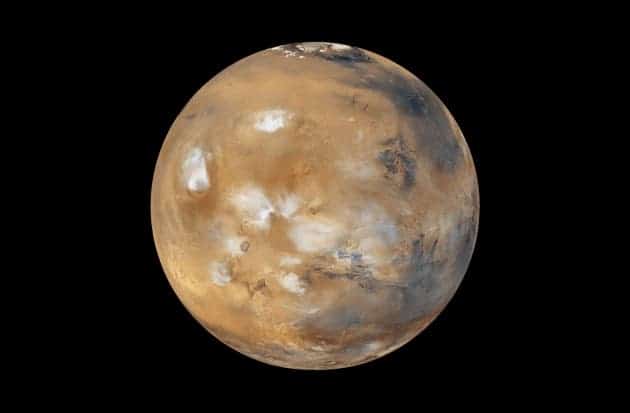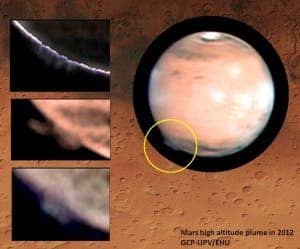Mysterious cloud-like formations hovering over Mars challenge our understanding of the Red Planet’s climate. Interestingly, amateur astronomers spotted the bizarre feature rising off the edge of the red planet in March and April of 2012 and since then, no satisfying answer regarding to their formation has been put forth. Now, scientists have concocted a new theory, but there’s only one problem – it poses more questions than it answers.

A team of astronomers led by astronomer Agustín Sánchez-Lavega of the University of the Basque Country in Bilbao, Spain suggests that the plume was either a cloud of ice particles or a Martian aurora. The haze extending more than 600 miles from the surface of Mars has scientists baffled.
“This observation is a big surprise,” says Aymeric Spiga, a planetary scientist at the University of Pierre and Marie Curie in Paris, who was not involved in the work. “Another puzzle on Mars!”
The thing is that the plumes/clouds were observed at great heights, and this is really hard to explain. The simplest possibility would be that the plumes were formed by shards of frozen carbon dioxide or water vapour, but if this is the case, then the atmosphere should be much colder than currently estimated. Another possibility is that Martian dust storms kicked dust up to the high altitudes, but this has not been observed before, and it’s not clear if it can actually happen. Astronomers also suggested that it may be an aurora – an interaction between charged particles from the Sun and a planet’s magnetic field – but there’s really no evidence supporting an aurora.

“We know in this region on Mars, there have been auroras reported before. But the intensities we are reporting are much much higher than any auroras seen before on Mars or on Earth. It would be 1,000 times stronger than the strongest aurora, and it is difficult to come to terms that Mars has such an intense aurora.”
Indeed, according to this new research, the most likely possibility is the ice plume.
“The ice plume is a little more reasonable,” says Nicholas Heavens, a planetary astronomer at Hampton University in Virginia
But no matter which possibility turns out to be true, it will redefine our understanding of the Martian atmosphere. Munoz hopes that, inspired by his paper, other astronomers will come up with other theories or refine the already existing ones. Until then, researchers wait for the phenomenon to repeat itself, in order to gather more data.
Journal Reference: et al. Nature http://dx.doi.org/10.1038/nature14162 (2015).


